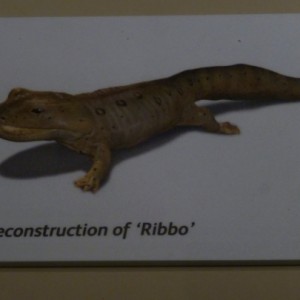Ribbo
On 4th February our U3a Geology group learned how Romer's Gap had been filled. Today Mr Flum and I attended Royal Scottish Museum on the first day of the exhibition of the evidence.
The gap was postulated by palaeontologist Alfred Romer in the 1950's regarding the absence of fossil evidence during the late Devonian and early Carboniferous periods (approximately 360 to 345 million years ago) of the tetrapod transition from aqueous to terrestrial dwelling, that is, from gill-breathing, swimming movement by flipper to air-breathing, walking on four legs, with five toes instead of seven or more. Other adaptations to land-dwelling would include evidence of a stiff backbone, flexible neck, terrestrial ears and eyes.
Extensive work by Stan Wood (who died on 9th September 2012) on a section of the Whiteadder River, a tributary of the Tweed in the Borders, discovered a variety of fossils, in particular Ribbo, a tetrapod with a significant ribcage, indicating a definitive ability to breathe on land (see extra for reconstruction of its appearance). (The fish-like shape of the exhibit is not significant). The work continues there, and at Burnmouth, as part of the TW:eed project.
The exhibition gives much more detail into timelines and samples. I found of particular interest the variety of scanning techniques available to determine the fossil content of specimens in 3D before they are split, so avoiding damage which erstwhile techniques inevitably caused.
The exhibition runs until 14th August.

Comments
Sign in or get an account to comment.


